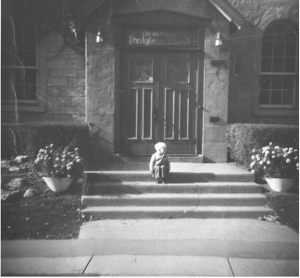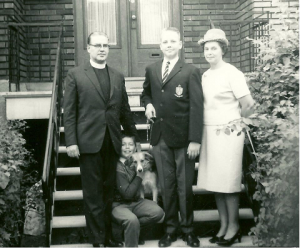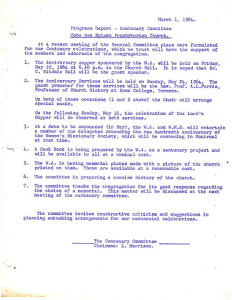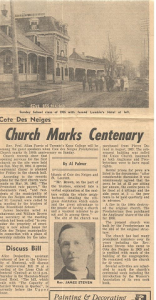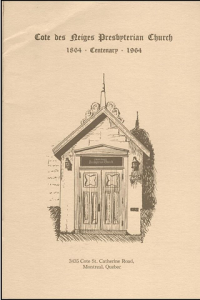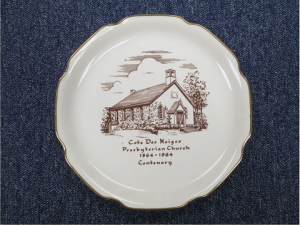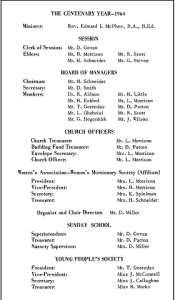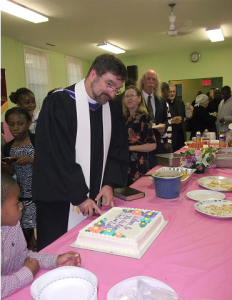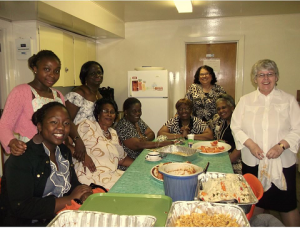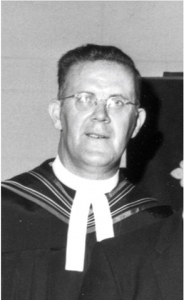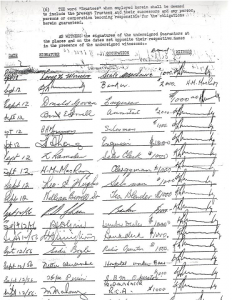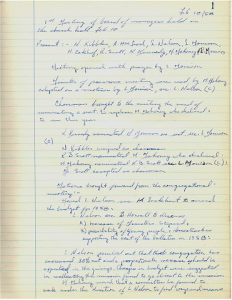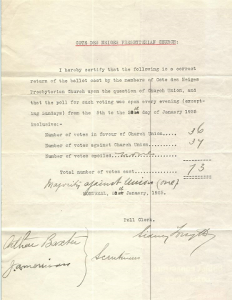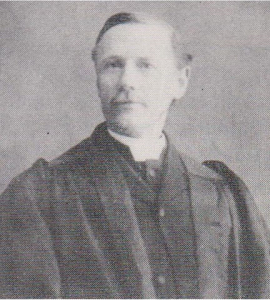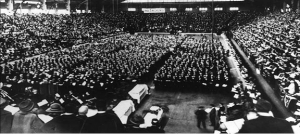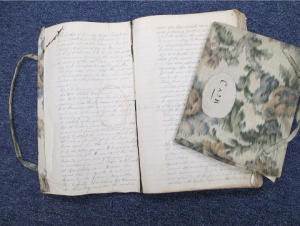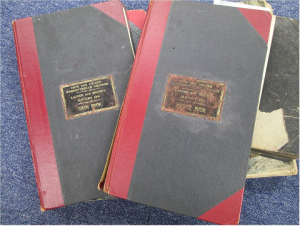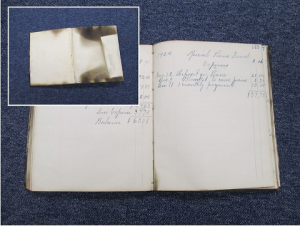Sunday May 31, 2020
Anniversary and Pentecost Sunday morning sermon
Anniversary and Pentecost Sunday morning sermon – May 31st, 2020
Welcome!This morning, we celebrate our church 156 years of existence, as well as the coming of the Holy Spirit on this day of Pentecost.Our minister, Rev. Joel Coppieters reminds us of how God has been our help in ages past and sermons us on the posture we should have for the coming years.The texts this morning are taken from Psalm 90 and 2 Chronicles 7:11-16. ? ? ? Happy anniversary and happy pentecost! ? ??
Posted by Cote des Neiges Presbyterian Church on Saturday, May 30, 2020
Welcome!
This morning, we celebrate our church 156 years of existence, as well as the coming of the Holy Spirit on this day of Pentecost.
Our minister, Rev. Joel Coppieters reminds us of how God has been our help in ages past and sermons us on the posture we should have for the coming years.
The texts this morning are taken from Psalm 90 and 2 Chronicles 7:11-16.
Happy anniversary and happy pentecost!
Saturday May 30, 2020
“A few of my favourite places” – CDN 156th anniversary
"A few of my favourite places" – CDN 156th anniversary – May 30th, 2020
As we celebrate our anniversary at Cote des Neiges Presbyterian Church this year, instead of the usual shared meal and special program on Saturday evening, you’re invited to a virtual historical tour, from the comfort of your own home!“A few of my favourite places” is a 30 minute visual presentation hosted by our minister, Rev. Joel Coppieters, that will lead you in gratitude to God for His goodness and care through 156 years of history.Happy anniversary!
Posted by Cote des Neiges Presbyterian Church on Friday, May 29, 2020
As we celebrate our anniversary at Cote des Neiges Presbyterian Church this year, instead of the usual shared meal and special program on Saturday evening, you’re invited to a virtual historical tour, from the comfort of your own home!
“A few of my favourite places” is a 30 minute visual presentation hosted by our minister, Rev. Joel Coppieters, that will lead you in gratitude to God for His goodness and care through 156 years of history.
Happy anniversary!
There is something about this simple little fieldstone church on a busy Montreal street that has the most powerful attraction.
Countless adults now well on in years still remember the wise words and kindness of Sunday School teachers long past. Years since they came through for just a few semesters at one of the nearby universities, many former students still hang on to the connections they made here. Long after they had moved on from their first affordable apartment in the neighbourhood, immigrant families remember the welcome they received here. There is clearly a reason why so many still attend decades after they first stepped through the front door into the understated warmth of the sanctuary.
Whether you’ve just missed the building since the pandemic shut down started two months ago, or it’s been years since you last visited, we’ve got a treat for you tonight. As part of the culmination of our anniversary week celebration, we invite you to join the minister for a special tour of the building that will help you reminisce, to discover things you might never have known about the place and to praise God for the ministry that so many of us have benefited from in this special place.
“A few of my favourite places …” hosted by Rev. Joel Coppieters, tonight (Saturday May 30th) at 7pm on Facebook and the webpage.
Friday May 29, 2020
When Rev. McPhee (pictured with his wife Margaret, and their sons Ian and Gordon in front of the manse on Northcliff) replaced Rev MacRury in 1963, the paint was still fresh in the new fellowship hall and the congregation was in the throes of planning their big centennial celebration.
The bulletins, and the planning meeting agendas and minutes were still being duplicated with the high-tech mimeograph machine that gave every sheet of paper a peculiar smell of rubbing alcohol and a strange purple hue which you can see in the planning notes from the meeting of March 1st, 1964. (Knowing how to operate these ancestors of the modern photocopy machine was apparently a pre-requisite to ministry for many years.)
The back page from the 1964 weekly bulletins gives an idea of the people involved both in the ongoing affairs of the church and of the celebration plans for the centennial. (Can you recognize a few of the names?)
The planning was thorough, and according to the newspaper clipping from the Montreal Gazette, the occasion was festive and things came together really well.
And of course, an event as important and auspicious as a centennial celebration had to be underlined by the two great Presbyterian traditions – a new cookbook especially assembled for the occasion, and a commemorative plate, presumably meant for display and not for sampling the cookbook recipes!
How great it is to know that as the years have passed, God has continued to do His work at Côte des Neiges with ordinary people like you and me. People with a purple stain on their white shirt cuffs from the mimeograph stencil, who couldn’t get enough of their favourite aunt’s casserole recipe and thought everybody at church should have it in the new cookbook, and who sat around for hours happily chatting after the Saturday evening anniversary meal was done and the dishes were being washed.
This is the history of Côte des Neiges Presbyterian Church and of God’s extraordinary work in and through the lives of everyday people like us.
Thursday May 28, 2020
The back part of our building is pretty important to us. Between the nursery, our little kitchen and the fellowship hall in the basement that is used for meals, and special events (like the most recent induction in the attached pictures!) and Sunday School, it’s hard to imagine doing ministry without them.
And yet, from 1864 until 1958 – almost a full 100 years – the church did not have them!
From 1945 to 1952, under the able leadership and engaging preaching of Rev Marcellus Kik the congregation had grown well. With great pastoral skill and ability in the pulpit and in leadership, Rev. Hector MacRury, the next minister (pictured below), helped to consolidate the congregation’s ministry. By that point, there was a definite need for more space – perhaps enlarging the sanctuary – and adding some classrooms for Sunday School and a nursery, facilities for some kind of food service and some utility space.
Working closely with the architects, a plan was developed that would increase the seating capacity in the sanctuary to 300, add a vestry, a choir room and meeting space on the main floor, and then in a new basement, the large multi purpose fellowship hall and the kitchen. The final cost estimate was tallied at $75,000. (The average annual income in the blue collar trades in Canada at that point was just above $4500.)
It proved difficult to raise the funds required and the project was broken into two parts. The architects estimated that the basement portion with the kitchen and the fellowship hall could be built first, at a lesser cost of $37,000, and the second story added later.
With only $8000 raised in donations, a loan was necessary. But that too proved difficult.
Hank Eekhof, who served with the board of managers during this process, remembers the bank manager’s reaction. “You guys are a white English Protestant Church in an immigrant neighbourhood, you’ll be closed in 5 years. There’s no way we’re giving you a loan or a mortgage.”
A trust company was approached, but unsure about the church’s future, they too required an unusual concession.
Over 30 of the men from the congregation would have to personally vouch for portions of the loan. On signing day, September 12th 1956, they all showed up at the trust company, and each in turn provided a personal guarantee for a portion of the loan $1000. $1500. $2000. If the church closed, went bankrupt or was unable to repay the loan, they would each be on the hook for their portion. Beside their names and their signatures on the document each one of them listed their occupation. Judging by this list, some of them were co-signing for over six month’s worth of income.
On the 10th of February 1958, for the very first time, the board of managers met in the brand new fellowship hall. (See the scanned page from the minute book.)
How much of the ministry we do now at Côte des Neiges depends on the hard work and sacrifices of previous generations. I wonder what legacy we are leaving to the next generation?
Wednesday May 27, 2020
Did you know that Côte des Neiges once came close to not being Presbyterian?
Sometimes a small decision can have long lasting consequences.
As changing trends in Canada’s immigration in the early 1900`s brought more people from a variety of different backgrounds, some felt it would be better to have one larger Protestant church to respond to the needs and challenges of the new culture. Several denominations were part of the discussions that lasted well over 20 years, though things stalled a little bit during World War I.
As the push for “church union” continued, many Presbyterians were concerned about losing their history and wondered about what this new church would believe. Would it hold to the same biblical standards?
While the Methodists and Congregationalists joined as a complete denomination, enough Presbyterians were hesitant that the decision was left up to each congregation – and if more than half its members wanted their local church to join the new United Church, it would.
The vote at Cote des Neiges was split exactly down the middle – 36 to 36! (Check the actual ballot tally with the signatures of the invigilators who must have counted two or three times just to be sure.)
While Presbyterian ministers don’t normally have the right to vote in church decisions – unless there is a tie! Rev. James Stevens (in the picture below) who had already been serving the congregation for 20 years when the vote was taken in 1925, broke the tie to remain Presbyterian. (Making the final vote tally 37 to 36 against joining the union.) The minister then went on to shepherd what must have been a very anxious little church.
It must have been nice to be part of the large overflow crowd at the opening worship of the United Church at the Mutual Street Arena in Toronto on the 19th of June 1925. (See the picture.)
In the months that followed, some of the members from Côte des Neiges left to join other United Church congregations in the city of Montreal, but along with hundreds of other like-minded congregations across Canada, Côte des Neiges Presbyterian went on to courageously hold to the biblical doctrines they had come to value.
Taking a stand isn’t always easy – but it has important long term effects.
Tuesday May 26, 2020
From the very beginning, women have played an important role at Côte des Neiges, and the meticulous records they kept – usually considerably more legible than the men’s handwriting in the “official” records – helps us to reconstruct an impressively varied number of supporting roles.
The original minute book and treasury record appear to have been damaged in one of the several fires throughout the church’s history, and had to be rebound. This was beautifully done with a hand stitched floral print pattern. In the first picture the page is open to the minutes of the founding meeting of the CDN Women’s Aid Society on Wednesday, October 19th, 1910.
The pages of this book, and those that follow, tell about the close pastoral care shared among the women of the congregation and their families – from supporting widows, helping the needy and providing support after an untimely pregnancy. But they also lead the congregation in promoting and supporting outreach into the community, missionary work and the worship life of the community.
The “cash” books lay out hundreds of projects for which funds were raised, literally a nickel and a dime at a time, by women who had little disposable income of their own, but what they had they gave generously – and when they didn’t have, they found a way to raise the funds.
One of the record books that barely survived the fire (see the coverleaf in the inset) is opened to the page for November 12th, 1924 where the women make an initial $25 deposit on what may have been the congregation’s first piano. The blanket purchased for $2.75 was needed to keep the piano from being damaged by the cold in a building that was never heated during the week.
Records from the time in the Canadian Mansard suggest that working men are averaging around $53 a week and that most of the women who work outside the home at this point are getting less than $10 for a full 47 hours.
